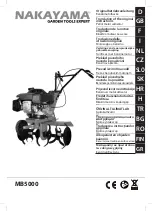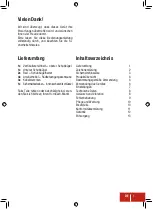
RLC-SVX19A-E4
51
Periodic Maintenance
• Possible low discharge superheat at high loads
• High con Subcooler pressure drop
Some of the symptoms of a refrigerant over-charged unit
• Condenser Pressure Limit
• High –Pressure Cutout diagnostic
• More-than-normal number of fans running
• Erratic fan control
• Higher-than-normal compressor power
• Very low discharge superheat at start up if the
refrigerant charge is correct the discharge superheat is
between 10°C and 15°C when the unit is running at full
load
• Compressor rattle or grinding sound at start up
Some of the symptoms of an oil over-charged unit
• Larger-than-normal evaporator approach temperatures
(Leaving-water-temperature – Saturated Evaporator
Temperature)
• Low Evaporator-refrigerant Temperature limit
• Low Refrigerant – Temperature Cutout diagnostic
• Low unit capacity
• Low discharge superheat (specially at high loads)
• Compressor rattle or grinding sound
• High oil-sump level after normal shutdown
Some of the symptoms of an oil under-charged unit
• Compressor rattling or grinding sound
• Lower-than-normal pressure drop through oil system
• Seized or Welded compressors
• Low oil-sump level after normal shutdown
• Lower-than-normal oil concentrations in the evaporator
R134a Field – Charging Procedure
This procedure should be followed when the unit is
empty of all refrigerant and under vacuum. Add the
charge through the evaporator service valve.
1.
Note the weight of the amount of charge removed.
Compare it to General Data tables. A difference in
charge may indicate a leak.
2. Attach the charging hose to the evaporator service
valve (9mm [3/8inch] fl are). Open the service valve.
3. Add charge to the evaporator to bring the total circuit
charge up to the level indicated in the above chart.
4. Close the service valve and disconnect the charging
hose.
Chiller settings
Prior starting refrigerant charge optimization, the
technician must insure the following chiller conditions:
• Constant water fl ow is strictly necessary during
the whole operation (water fl ow to be within allowed
operating range)
• A fully loaded chiller is highly recommended for a
successful operation. In case the technician is not able to
ensure a 2 circuit fully loaded chiller then he must lockout
one circuit and perform charge optimization for
1 circuit at a time
• When the refrigenrant charge optimization is done per
circuit the chiller load must not be lower than 60%
This procedure should be followed when adding
refrigerant to an undercharged unit:
1.
Attach the charging hose to the evaporator service
valve (9mm [3/8inch] fl are). Open the service valve.
2. Fix the leaving water set point (water temperature to
be steady as much as possible).
3. Adjust water fl ow within operating range and keep it
steady.
a) Note apporach temperatute T1
b) Add 2kg of R134a refrigerant
c) Note approach temperature T2
d) If Tn - Tn+1 < 0.2 (with n=1
→
charge addition
count) then charge is good and optimization is done
e) If Tn - Tn+1 > 0.2 (with n=1
→
charge addition
count) then perform steps b) to e) if needed
This procedure should be followed when removing
refrigerant to an overcharged unit:
1. Fix the leaving water set point (water temperature to
be steady as much as possible)
2. Adjust water fl ow within operating range and keep it
steady
a) Note apporach temperatute T1
b) Add 2kg of R134a refrigerant
c) Note approach temperature T2
d) Keep performing step b until Tm+1
- Tm > 0.5 (with m = 1 > charge removal count)
e) Once step d) is confi rmed add 4kg og R134a
refrigerant and note T3
f) If T1-Tn < 0.2 (with n = 3
→
charge addition count)
then charge is good and optimization is done
g) If T1-Tn > (with n = 3
→
charge addition count) then
perform step e) to f) if needed
Isolation of the Refrigerant Charge
on the Low side of the System
By closing the suction-line service valve, refrigerant
charge can be isolated in the evaporator for maintenance
on the compressor.
Returning the unit to running conditions:
1. Open all the valves.
2. Manually Open EXV for 15 minutes to allow the
refrigerant drain to the evaporator by gravity.
3. Let the unit sit with heaters on to drive refrigerant
out of the oil and warm up the compressor bearings.
Depending upon ambient conditions, this may take
up to 24 hours.
4. After the oil level has returned to normal, the unit
can be put back into operation.
Содержание RTAF HE Series
Страница 3: ...RLC SVX19A E4 3...
Страница 36: ...RLC SVX19A E4 36 General Electrical Recommendations Figure 19 Warning Label...
Страница 59: ...RLC SVX19A E4 59 Notes...










































